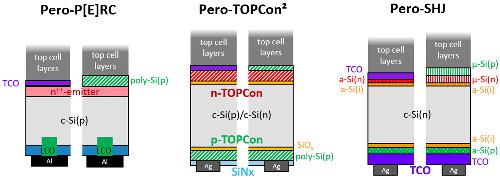当前位置:
X-MOL 学术
›
Prog. Photovoltaics
›
论文详情
Our official English website, www.x-mol.net, welcomes your feedback! (Note: you will need to create a separate account there.)
The race for the best silicon bottom cell: Efficiency and cost evaluation of perovskite–silicon tandem solar cells
Progress in Photovoltaics ( IF 6.7 ) Pub Date : 2020-11-27 , DOI: 10.1002/pip.3372 Christoph Messmer 1, 2 , Baljeet S. Goraya 1 , Sebastian Nold 1 , Patricia S.C. Schulze 1 , Volker Sittinger 3 , Jonas Schön 1, 2 , Jan Christoph Goldschmidt 1 , Martin Bivour 1 , Stefan W. Glunz 1, 2 , Martin Hermle 1
Progress in Photovoltaics ( IF 6.7 ) Pub Date : 2020-11-27 , DOI: 10.1002/pip.3372 Christoph Messmer 1, 2 , Baljeet S. Goraya 1 , Sebastian Nold 1 , Patricia S.C. Schulze 1 , Volker Sittinger 3 , Jonas Schön 1, 2 , Jan Christoph Goldschmidt 1 , Martin Bivour 1 , Stefan W. Glunz 1, 2 , Martin Hermle 1
Affiliation

|
Perovskite–silicon tandem solar cells have shown a rapid progress within the past 5 years in terms of their research cell efficiency and are currently being investigated as candidates for the next generation of industrial PV devices. This raises the question of which silicon bottom cell will be most suitable for tandem application. Currently, the silicon heterojunction (SHJ) technology dominates in tandem research achieving world records. However, it is an open issue of how to transfer these research results to industrial mass production, which is driven by cost reduction and resource efficiency and includes challenges like upscaling and long-term stability. Therefore, it is highly relevant for the PV industry to get reliable and predictive estimates on the efficiency and cost potential, as well as technologically feasible solutions. In this work, we elaborate on silicon bottom cell concepts based on the PERC, TOPCon, and SHJ technology combined with two different interconnection concepts. For each tandem device, the efficiency potential is investigated by means of an experimentally validated simulation model. Second, we evaluate the bottom cell concepts in terms of all-in cell costs per piece. Bringing the efficiency potential and cost evaluation together allows us to assess the different tandem cell concepts in terms of all-in module cost per watt peak. Our results show that perovskite–silicon tandem devices are promising candidates to significantly reduce the levelized cost of electricity and, in particular, that the “race” for the best silicon bottom cell is still open to all the investigated bottom cell technologies.
中文翻译:

最佳硅底电池竞赛:钙钛矿-硅串联太阳能电池的效率和成本评估
钙钛矿-硅串联太阳能电池在过去 5 年中在电池效率研究方面取得了快速进展,目前正在研究作为下一代工业光伏器件的候选材料。这就提出了哪种硅底电池最适合串联应用的问题。目前,硅异质结 (SHJ) 技术在串联研究中占据主导地位,并创造了世界纪录。然而,如何将这些研究成果转化为工业化量产是一个悬而未决的问题,这是由成本降低和资源效率驱动的,包括升级和长期稳定性等挑战。因此,对于光伏行业而言,获得对效率和成本潜力以及技术上可行的解决方案的可靠和预测性估计非常重要。在这项工作中,我们详细阐述了基于 PERC、TOPCon 和 SHJ 技术结合两种不同互连概念的硅底电池概念。对于每个串联设备,通过实验验证的模拟模型研究效率潜力。其次,我们根据每件总电池成本评估底部电池概念。将效率潜力和成本评估结合在一起,使我们能够根据每瓦峰值的全模块成本来评估不同的串联电池概念。我们的结果表明,钙钛矿-硅串联器件是显着降低电力平均成本的有希望的候选者,特别是,最佳硅底电池的“竞赛”仍然对所有研究的底电池技术开放。TOPCon 和 SHJ 技术结合了两种不同的互连概念。对于每个串联设备,通过实验验证的模拟模型研究效率潜力。其次,我们根据每件总电池成本评估底部电池概念。将效率潜力和成本评估结合在一起,使我们能够根据每瓦峰值的全模块成本来评估不同的串联电池概念。我们的结果表明,钙钛矿-硅串联器件是显着降低电力平均成本的有希望的候选者,特别是,最佳硅底电池的“竞赛”仍然对所有研究的底电池技术开放。TOPCon 和 SHJ 技术结合了两种不同的互连概念。对于每个串联设备,通过实验验证的模拟模型研究效率潜力。其次,我们根据每件总电池成本评估底部电池概念。将效率潜力和成本评估结合在一起,使我们能够根据每瓦峰值的全模块成本来评估不同的串联电池概念。我们的结果表明,钙钛矿-硅串联器件是显着降低电力平均成本的有希望的候选者,特别是,最佳硅底电池的“竞赛”仍然对所有研究的底电池技术开放。通过实验验证的模拟模型研究了效率潜力。其次,我们根据每件总电池成本评估底部电池概念。将效率潜力和成本评估结合在一起,使我们能够根据每瓦峰值的全模块成本来评估不同的串联电池概念。我们的结果表明,钙钛矿-硅串联器件是显着降低电力平均成本的有希望的候选者,特别是,最佳硅底电池的“竞赛”仍然对所有研究的底电池技术开放。通过实验验证的模拟模型研究了效率潜力。其次,我们根据每件总电池成本评估底部电池概念。将效率潜力和成本评估结合在一起,使我们能够根据每瓦峰值的全模块成本来评估不同的串联电池概念。我们的结果表明,钙钛矿-硅串联器件是显着降低电力平均成本的有希望的候选者,特别是,最佳硅底电池的“竞赛”仍然对所有研究的底电池技术开放。将效率潜力和成本评估结合在一起,使我们能够根据每瓦峰值的全模块成本来评估不同的串联电池概念。我们的结果表明,钙钛矿-硅串联器件是显着降低电力平均成本的有希望的候选者,特别是,最佳硅底电池的“竞赛”仍然对所有研究的底电池技术开放。将效率潜力和成本评估结合在一起,使我们能够根据每瓦峰值的全模块成本来评估不同的串联电池概念。我们的结果表明,钙钛矿-硅串联器件是显着降低电力平均成本的有希望的候选者,特别是,最佳硅底电池的“竞赛”仍然对所有研究的底电池技术开放。
更新日期:2020-11-27
中文翻译:

最佳硅底电池竞赛:钙钛矿-硅串联太阳能电池的效率和成本评估
钙钛矿-硅串联太阳能电池在过去 5 年中在电池效率研究方面取得了快速进展,目前正在研究作为下一代工业光伏器件的候选材料。这就提出了哪种硅底电池最适合串联应用的问题。目前,硅异质结 (SHJ) 技术在串联研究中占据主导地位,并创造了世界纪录。然而,如何将这些研究成果转化为工业化量产是一个悬而未决的问题,这是由成本降低和资源效率驱动的,包括升级和长期稳定性等挑战。因此,对于光伏行业而言,获得对效率和成本潜力以及技术上可行的解决方案的可靠和预测性估计非常重要。在这项工作中,我们详细阐述了基于 PERC、TOPCon 和 SHJ 技术结合两种不同互连概念的硅底电池概念。对于每个串联设备,通过实验验证的模拟模型研究效率潜力。其次,我们根据每件总电池成本评估底部电池概念。将效率潜力和成本评估结合在一起,使我们能够根据每瓦峰值的全模块成本来评估不同的串联电池概念。我们的结果表明,钙钛矿-硅串联器件是显着降低电力平均成本的有希望的候选者,特别是,最佳硅底电池的“竞赛”仍然对所有研究的底电池技术开放。TOPCon 和 SHJ 技术结合了两种不同的互连概念。对于每个串联设备,通过实验验证的模拟模型研究效率潜力。其次,我们根据每件总电池成本评估底部电池概念。将效率潜力和成本评估结合在一起,使我们能够根据每瓦峰值的全模块成本来评估不同的串联电池概念。我们的结果表明,钙钛矿-硅串联器件是显着降低电力平均成本的有希望的候选者,特别是,最佳硅底电池的“竞赛”仍然对所有研究的底电池技术开放。TOPCon 和 SHJ 技术结合了两种不同的互连概念。对于每个串联设备,通过实验验证的模拟模型研究效率潜力。其次,我们根据每件总电池成本评估底部电池概念。将效率潜力和成本评估结合在一起,使我们能够根据每瓦峰值的全模块成本来评估不同的串联电池概念。我们的结果表明,钙钛矿-硅串联器件是显着降低电力平均成本的有希望的候选者,特别是,最佳硅底电池的“竞赛”仍然对所有研究的底电池技术开放。通过实验验证的模拟模型研究了效率潜力。其次,我们根据每件总电池成本评估底部电池概念。将效率潜力和成本评估结合在一起,使我们能够根据每瓦峰值的全模块成本来评估不同的串联电池概念。我们的结果表明,钙钛矿-硅串联器件是显着降低电力平均成本的有希望的候选者,特别是,最佳硅底电池的“竞赛”仍然对所有研究的底电池技术开放。通过实验验证的模拟模型研究了效率潜力。其次,我们根据每件总电池成本评估底部电池概念。将效率潜力和成本评估结合在一起,使我们能够根据每瓦峰值的全模块成本来评估不同的串联电池概念。我们的结果表明,钙钛矿-硅串联器件是显着降低电力平均成本的有希望的候选者,特别是,最佳硅底电池的“竞赛”仍然对所有研究的底电池技术开放。将效率潜力和成本评估结合在一起,使我们能够根据每瓦峰值的全模块成本来评估不同的串联电池概念。我们的结果表明,钙钛矿-硅串联器件是显着降低电力平均成本的有希望的候选者,特别是,最佳硅底电池的“竞赛”仍然对所有研究的底电池技术开放。将效率潜力和成本评估结合在一起,使我们能够根据每瓦峰值的全模块成本来评估不同的串联电池概念。我们的结果表明,钙钛矿-硅串联器件是显着降低电力平均成本的有希望的候选者,特别是,最佳硅底电池的“竞赛”仍然对所有研究的底电池技术开放。



























 京公网安备 11010802027423号
京公网安备 11010802027423号